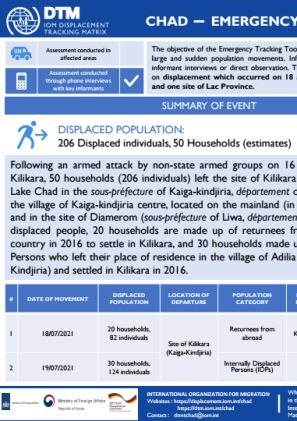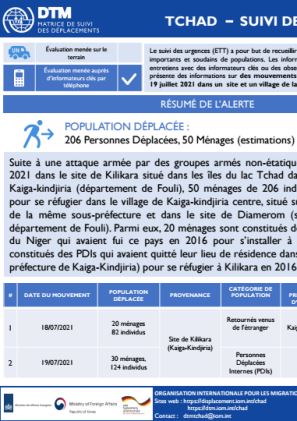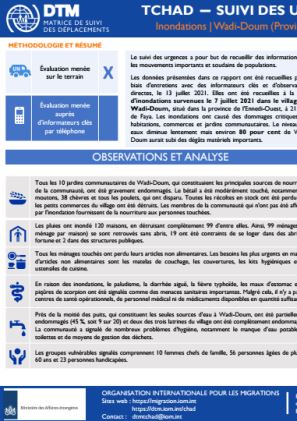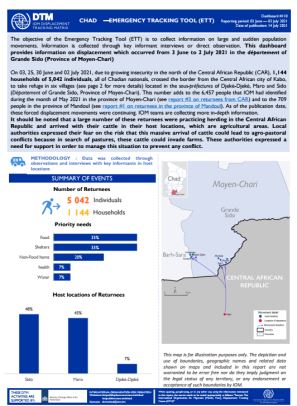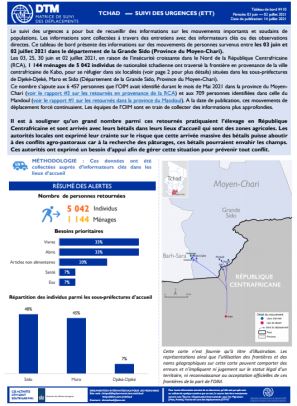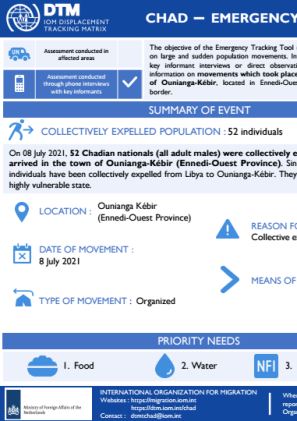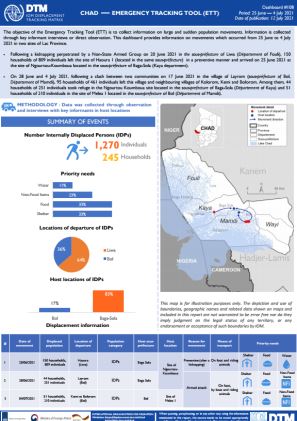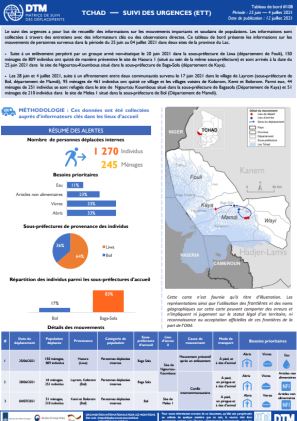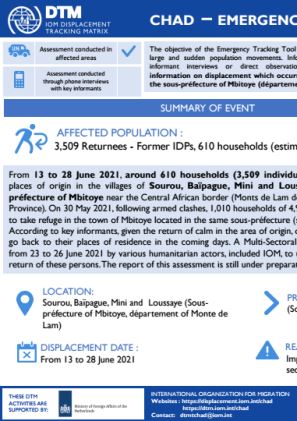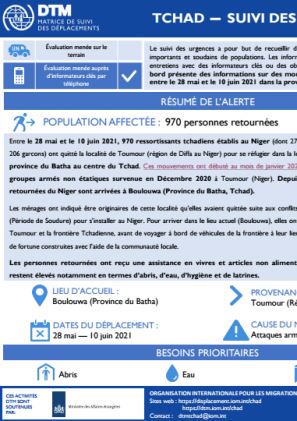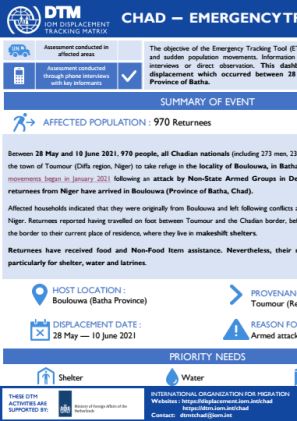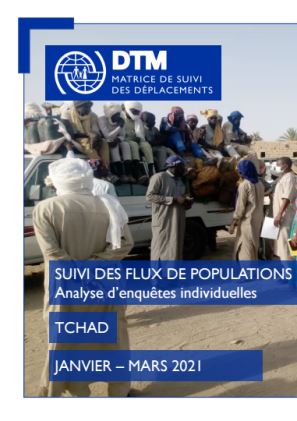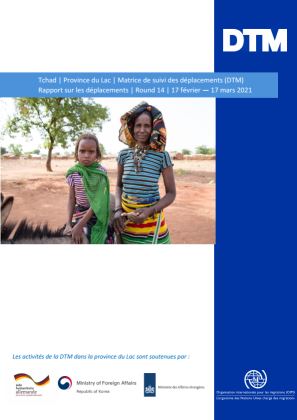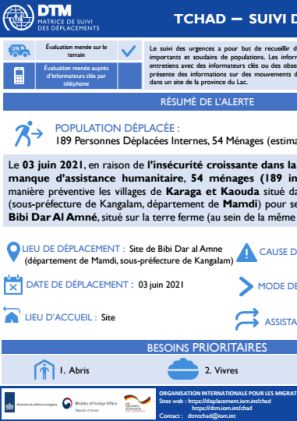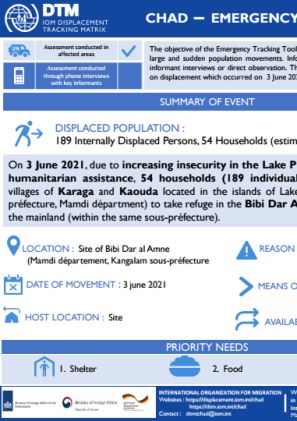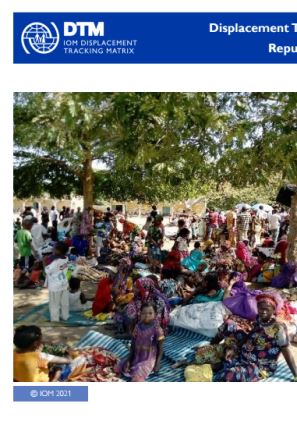-
Countries
-
Data and Analysis
-
Special Focus
-
Crisis Responses
Chad
IDPs tracked
Displacement Movements
452,000
IDMC 2023
Data collection round
About Chad
Since 2014, the International Organization for Migration (IOM) has been working with the Government of Chad and other relevant partners to conduct displacement and flow monitoring across multiple provinces of Chad: Lac, Moyen-Chari, Logone Oriental, Borkou, Tibesti, Borkou and Ennedi Ouest.
The displacement dynamic analysis is rooted in the experiences of the 2011 response to the Libya crisis during which IOM supported more than 150,000 people arriving in northern Chad. Since then, numerous crises, including the Lake Chad Bassin crisis, the crisis in the Central African Republic and recurring displacement dynamics in Libya and Sudan have necessitated the development of a coherent approach to monitoring of migration flows to Chad. Most recently, the renewed interest in Chad as a transit and departure country for migrant flows towards Libya and potentially onwards to Europe, have inspired a new quality and coherence in IOM’s migration data management approach in Chad.
The Displacement Tracking Matrix (DTM) is an information management system that tracks and monitors the displacement and population mobility. It is designed to regularly capture, process, and disseminate various layers of information to provide a better understanding of the evolving needs of mobile populations, on site or en route both of forced displacement and other migration flows. Adapted from the global methodology, relevant DTM components are being carried out in targeted locations to facilitate displacement management, the delivery of immediate humanitarian services and emergency response, informing transition and durable solutions and development-centred policy.
Since its launch, DTM has grown to a fully integrated component of the national and sub-national humanitarian information management architecture, informing the Government of Chad and international response both humanitarian and developmental across the majority of sectors/clusters and as part of the commitment of the international community and the Government of Chad to the New Way of Working (NWOW) as part of the humanitarian-development nexus.
Contact
DTM Chad
DTMChadCoordinationTeam@iom.int
Current Donors
- USAID
- Netherlands
- CERF
- Peace Building Fund
- Spain
Chad — Emergency Tracking Tool Report 113 (26 July 2021)
On 21 July 2021, following an outbreak of violence over a land dispute involving two communities, 25 households (102 individuals) fled the villages of Layrom and Tchougoudi located in the sous-préfecture of Bol (Département of Mamdi) to take refuge in the Yakoua site, located in the same sous-pré
Chad — Emergency Tracking Tool Report 112 (18 — 19 July 2021)
Following an armed attack by non-state armed groups on 16 July 2021 in the site of Kilikara, 50 households (206 individuals) left the site of Kilikara located in the islands of Lake Chad in the sous-préfecture of Kaiga-kindjiria, département of Fouli) to take refuge in the village of Kaiga-kindji
Tchad — Suivi Des Urgences 112 (18 — 19 Juillet 2021)
Suite à une attaque armée par des groupes armés non-étatiques survenue le 16 juillet 2021 dans le site de Kilikara situé dans les îles du lac Tchad de la sous-préfecture de Kaiga-kindjiria (département de Fouli), 50 ménages de 206 individus ont quitté ce site pour se réfugier dans le village de K
Tchad — Suivi Des Urgences 111 (07 Juillet 2021)
Ce tableau de bord ont été recueillies par le biais d'entretiens avecdes informateurs clés et d'observations directes, le 13 juillet 2021.Ce rapport présente les données recueillies à la suited'inondations survenues le 7 juillet 2021 à Wadi-Doum,
Jul 15 2021
Tchad — Suivi Des Urgences 111 (07 Juillet 2021)
Chad — Emergency Tracking Tool Report 111 (07 July 2021)
Information on this dashboard was collected through keyinformant interviews and direct observation, on 13 July 2021.Data was collected on individuals impacted by heavy rainsand severe flooding on 7 July 2021, in Wadi-Doum, located
Chad — Emergency Tracking Tool Report 110 (03 June — 14 July 2021)
On 03, 25, 30 June and 02 July 2021, due to growing insecurity in the north of the Central African Republic (CAR), 1,144 households of 5,042 individuals, all of Chadian nationals, crossed the border from the Central African city of Kabo, to take refuge in six villages (see page 2 for more details
Tchad — Suivi Des Urgences 110 (03 Juin — 02 Juillet 2021)
Les 03, 25, 30 juin et 02 juillet 2021, en raison de l’insécurité croissante dans le Nord de la République Centrafricaine (RCA), 1 144 ménages de 5 042 individus de nationalité tchadienne ont traversé la frontière en provenance de la ville centrafricaine de Kabo, pour se réfugier dans six localit
Tchad — Suivi Des Urgences 109 (08 Juillet 2021)
Le 08 juillet 2021, 52 personnes de nationalité tchadienne (tous des hommes adultes) collectivement expulsées de la Libye, sont arrivées dans la ville d’Ounianga Kébir (province de l’Ennedi-Ouest).
Jul 14 2021
Tchad — Suivi Des Urgences 109 (08 Juillet 2021)
Chad — Emergency Tracking Tool Report 109 (08 July 2021)
On 08 July 2021, 52 Chadian nationals (all adult males) were collectively expelled from Libya and arrived in the town of Ounianga-Kébir (Ennedi-Ouest Province). Since mid-April 2020, 1,667 individuals have been collectively expelled from Libya to Ounianga-Kébir.
Chad — Emergency Tracking Tool Report 108 (25 June— 04 July 2021)
Following a kidnapping perpetrated by a Non-State Armed Group on 20 June 2021 in the sous-préfecture of Liwa (Département of Fouli), 150 households of 809 individuals left the site of Haoura 1 (located in the same sous-préfecture) in a preventive manner and arrived on 25 June 2021 at the site
Tchad — Suivi Des Urgences 108 (25 Juin — 04 Juillet 2021)
Suite à un enlèvement perpétré par un groupe armé non-étatique le 20 juin 2021 dans la sous-préfecture de Liwa (département de Fouli), 150 ménages de 809 individus ont quitté de manière préventive le site de Haoura 1 (situé au sein de la même sous-préfecture) et sont arrivés à la date du 25 juin
Chad — Emergency Tracking Tool Report 107 (28 June 2021)
The objective of the Emergency Tracking Tool (ETT) is to collect information on large and sudden population movements. Information is collected through key informant interviews or direct observation.
Tchad — Suivi Des Urgences 107 (28 Juin 2021)
Le suivi des urgences a pour but de recueillir des informations sur les mouvements importants et soudains de populations. Les informations sont collectées à travers des entretiens avec des informateurs clés ou des observations directes.
Jul 06 2021
Tchad — Suivi Des Urgences 107 (28 Juin 2021)
Tchad — Suivi des Urgences 106 (13 — 28 June 2021)
Du 13 au 28 juin 2021, environ 610 ménages (3 509 individus) sont rentrés dans leurs lieux de résidence dans les villages de Sourou, Baïpague, Mini et Loussaye situés dans la sous-préfecture de Mbitoye près de la frontière centrafricaine (département de Monts de Lam, Province du Logone Oriental).
Chad — Emergency Tracking Tool Report 106 (13 — 28 June 2021)
From 13 to 28 June 2021, around 610 households (3,509 individuals) have returned to their places of origin in the villages of Sourou, Baïpague, Mini and Loussaye located in the sous-préfecture of Mbitoye near the Central African border (Monts de Lam département, Logone Oriental Province).
Tchad — Suivi des Urgences — Aperçu de la situation des retournés affectés par les affrontements en République centrafricaine — Villages de Nanabaria, Maissou, Maibo, Boumou et Maya (21—26 Mai 2021)
L’outil de suivi des urgences (ETT, Emergency Tracking Tool) de la Matrice de suivi des déplacements (DTM, Displacement Tracking Matrix) a pour but de recueillir des informations sur les mouvements importants et soudains de populations.
Chad — Emergency Tracking Tool Report — Overview of the situation of returnees affected by conflict in the Central African Republic — Villages of Nanabaria, Maissou, Maibo, Boumou and Maya (21—26 May 2021)
The objective of the Emergency Tracking Tool (ETT) of the Displacement Tracking Matrix (DTM) is to collect information on large and sudden population movements.
Tchad — Suivi des Urgences 105 (28 Mai — 10 Juin 2021)
Le suivi des urgences a pour but de recueillir des informations sur les mouvements importants et soudains de populations. Les informations sont collectées à travers des entretiens avec des informateurs clés ou des observations directes.
Chad — Emergency Tracking Tool Report 105 (28 May — 10 June 2021)
The objective of the Emergency Tracking Tool (ETT) is to collect information on large and sudden population movements. Information is collected through key informant interviews or direct observation.
Tchad — Suivi des flux de populations — Analyse d'enquêtes individuelles (Janvier — Mars 2021)
Afin de mieux comprendre les mouvements et tendances migratoires en Afrique de l’Ouest et du Centre, l’OIM, à travers la Matrice de suivi des déplacements (Displacement Tracking Matrix, DTM), met en œuvre l’activité de Suivi des flux de populations (Flow Monitoring, FM).
Tchad — Rapport sur les déplacements 14 (17 février — 17 mars 2021)
La Matrice de suivi des déplacements, tiré de l’anglais Displacement Tracking Matrix (DTM), est un outil de l’Organisation internationale pour les migrations (OIM) conceptualisé en 2004, qui permet de faire le suivi des déplacements et mobilités des populations.
Tchad — Suivi des Urgences 104 (4 Juin 2021)
Le suivi des urgences a pour but de recueillir des informations sur les mouvements importants et soudains de populations. Les informations sont collectées à travers des entretiens avec des informateurs clés ou des observations directes.
Jun 10 2021
Tchad — Suivi des Urgences 104 (4 Juin 2021)
Chad — Emergency Tracking Tool Report 104 (4 June 2021)
The objective of the Emergency Tracking Tool (ETT) is to collect information on large and sudden population movements. Information is collected through key informant interviews or direct observation.
Chad — Emergency Tracking Tool Report — Profile of Populations Affected by Conflict in the Central African Republic — Sites of Ngandaza and Sido-Centre (June 2021)
The objective of DTM’s (Displacement Tracking Matrix) Emergency Tracking Tool (ETT) is to collect information on large and sudden population movements.



